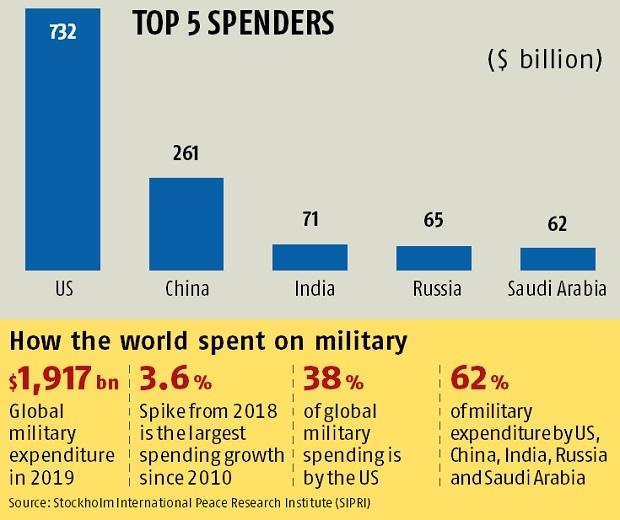Increased Global Military Expenditure: The Impact Of The Ukraine Conflict

Table of Contents
The Surge in Defense Budgets Following the Ukraine Invasion
Russia's invasion of Ukraine triggered an immediate and dramatic increase in defense spending across the globe. Nations, particularly those within NATO and in Eastern Europe, reacted swiftly to perceived threats, leading to a substantial reallocation of resources towards military preparedness. The Stockholm International Peace Research Institute (SIPRI) reported a significant percentage increase in global military expenditure in the year following the invasion, marking the largest annual rise since the start of the Cold War.
For example, several NATO members significantly boosted their defense budgets. Poland, directly bordering Ukraine, experienced a massive increase, allocating a far greater percentage of its GDP to military spending than in previous years. Similarly, several other Eastern European nations saw dramatic increases in their defense budgets, reflecting their heightened sense of vulnerability. This increase isn't solely about numbers; it represents a fundamental shift in national priorities.
- Increased spending on weapons procurement: Demand for advanced weaponry, including air defense systems, artillery, and armored vehicles, skyrocketed.
- Expansion of military personnel: Many countries are increasing the size of their armed forces, either through conscription or increased recruitment.
- Investment in cyber warfare capabilities: Recognizing the increasing importance of cyberattacks in modern warfare, nations are investing heavily in cybersecurity and defensive capabilities.
- Strengthening of border defenses: Heightened security concerns are leading to significant investment in border fortifications and surveillance technologies.
Shifting Geopolitical Landscape and its Effect on Military Spending
The Ukraine conflict has fundamentally reshaped the geopolitical landscape, exacerbating existing tensions and fostering a renewed focus on military preparedness. The conflict has invigorated existing alliances like NATO, prompting member states to reassess their defense strategies and bolster their collective security posture. This has resulted in a significant collective increase in global defense spending.
The impact extends beyond NATO members. Countries previously less focused on military spending, now facing a heightened sense of global insecurity, are reevaluating their defense postures and increasing military expenditure. The perception of a more volatile and unpredictable international environment is driving this change.
- Strengthening of NATO alliances and increased interoperability: NATO members are enhancing their military cooperation and interoperability, investing in joint training exercises and equipment standardization.
- Re-evaluation of defense strategies by non-NATO members: Countries outside of NATO are also reassessing their security needs and increasing defense spending to address perceived threats.
- Increased focus on energy security and its connection to defense: The conflict highlighted the vulnerability of nations reliant on Russian energy, emphasizing the strategic importance of energy security and its direct link to national defense.
- Growth in arms production and sales: The increased demand for weapons systems has spurred a significant increase in arms production and sales, further fueling the rise in global military expenditure.
The Economic Consequences of Increased Military Expenditure
The massive increase in global military spending carries significant economic consequences. The opportunity cost is substantial: the resources channeled into defense could have been used for crucial social programs, healthcare, education, and infrastructure development. This shift in priorities has the potential to negatively impact long-term economic growth and societal well-being.
The substantial increase in defense budgets also strains national finances. Many countries are facing increased national debts, potentially leading to inflationary pressures and reduced fiscal space for other essential public services. This economic pressure creates a dilemma between national security and economic development.
- Strain on national budgets: Increased military spending directly reduces the funds available for other critical government programs.
- Potential for reduced investment in social services: Cutbacks in education, healthcare, and other vital social programs are a potential consequence of diverting resources to defense.
- Impact on economic growth and development: Over-reliance on military spending can stifle economic growth by diverting resources away from more productive sectors.
- Increased risk of debt accumulation: Significant increases in defense budgets can exacerbate national debt levels, jeopardizing long-term fiscal sustainability.
Long-Term Implications of the Ukraine Conflict on Global Military Expenditure
The Ukraine conflict’s impact on global military expenditure is likely to be long-lasting. The potential for a new arms race, driven by a heightened perception of threat and competition for global influence, is a significant concern. This could lead to a prolonged period of high military spending, diverting resources from other pressing global challenges.
- Prolonged periods of high military spending: The current trend suggests that high levels of military expenditure may persist for years to come.
- Potential for escalating conflicts: Increased military capabilities can inadvertently increase the risk of further conflicts and regional instability.
- Development of new military technologies: The conflict is likely to accelerate the development and deployment of new and potentially destabilizing military technologies.
- Shift in global power dynamics: The conflict is reshaping global power dynamics, potentially leading to new alliances and shifts in regional influence.
Conclusion: The Lasting Impact of the Ukraine Conflict on Global Military Spending
The Ukraine conflict has had a profound and far-reaching impact on global military expenditure. The substantial increase in defense budgets worldwide, the shifting geopolitical landscape, and the long-term economic and security implications are all direct consequences of this ongoing conflict. Analyzing military expenditure in this context is crucial. The implications extend far beyond the battlefield, influencing national economies, societal priorities, and the global security architecture. We urge readers to further research the topic of increased global military expenditure and its consequences, focusing on analyzing military expenditure data to understand the ramifications of the Ukraine conflict on global security and economies, examining global defense spending trends and their impact on various nations. Understanding these trends is vital to navigating the challenges of an increasingly complex and unpredictable world.

Featured Posts
-
 Canadian Federal Election Mark Carneys Liberals Secure Victory
Apr 30, 2025
Canadian Federal Election Mark Carneys Liberals Secure Victory
Apr 30, 2025 -
 44 Year Old Channing Tatum Reportedly Dating 25 Year Old Inka Williams
Apr 30, 2025
44 Year Old Channing Tatum Reportedly Dating 25 Year Old Inka Williams
Apr 30, 2025 -
 Unexpected Family Ties Nba Legend And Ru Pauls Drag Race Contestant
Apr 30, 2025
Unexpected Family Ties Nba Legend And Ru Pauls Drag Race Contestant
Apr 30, 2025 -
 Churchill Downs Weather Response Plan Ensuring Derby Week Safety
Apr 30, 2025
Churchill Downs Weather Response Plan Ensuring Derby Week Safety
Apr 30, 2025 -
 Arqam Jwanka Almthyrt Llqlq Fy Nady Alnsr Hqayq Warqam
Apr 30, 2025
Arqam Jwanka Almthyrt Llqlq Fy Nady Alnsr Hqayq Warqam
Apr 30, 2025
